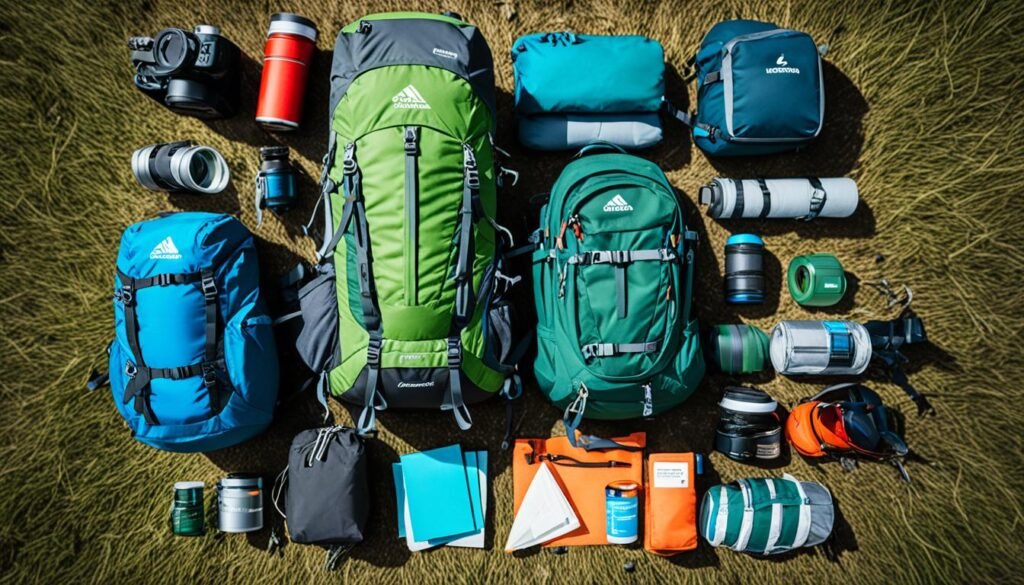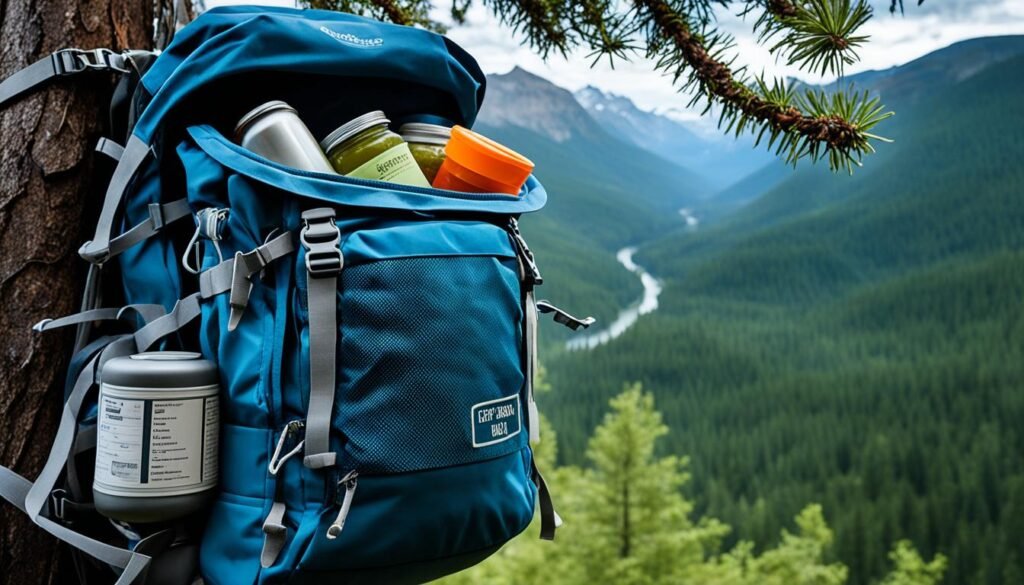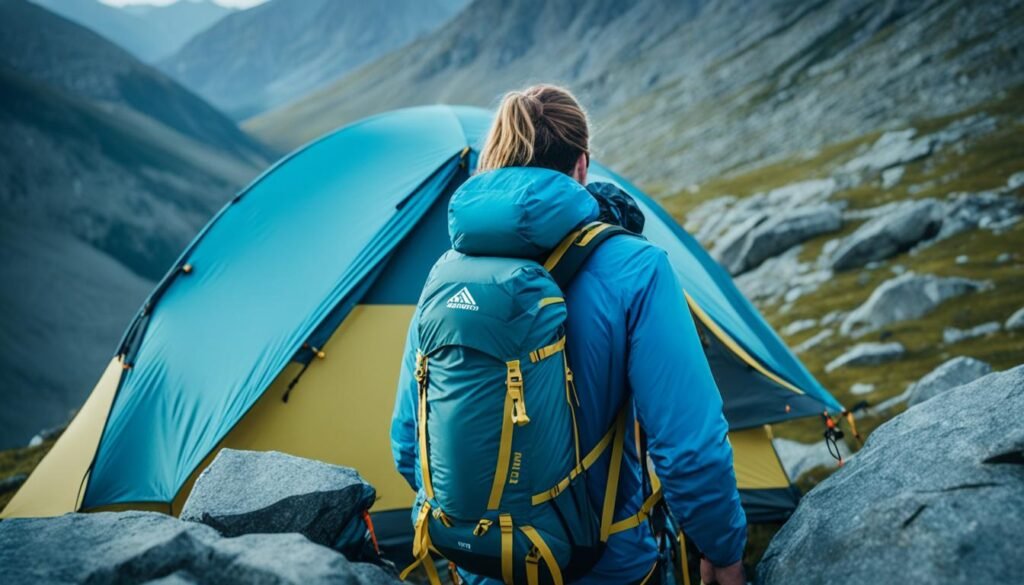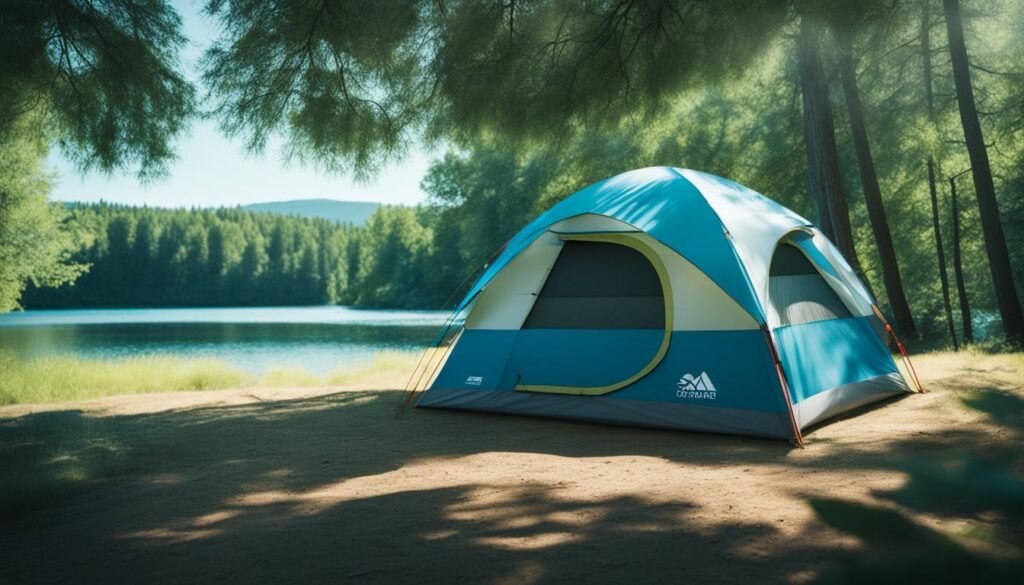When hiking or backpacking, it’s important to properly pack and attach your tent to your backpack to optimize space, balance, and comfort. This comprehensive guide will provide you with tips and techniques for attaching a tent to your backpack, ensuring a hassle-free outdoor adventure.
Key Takeaways:
- Learn how to pack a tent in a backpack with an internal frame or an external frame.
- Consider splitting up the tent components between hikers for a more balanced load.
- Choose the right backpack that provides adequate space for your tent.
- Prepare your tent by ensuring it is dry and neatly rolled or folded.
- Pack your backpack strategically to evenly distribute weight and prioritize accessibility.
How to Pack a Tent in a Backpack (Internal Frame)
Packing a tent in a backpack with an internal frame requires a systematic approach. To ensure a smooth and efficient packing process, follow these tent packing tips:
- Choose a backpack with an internal frame that provides sufficient space for your tent. This will ensure that your backpack can comfortably accommodate the tent and distribute its weight evenly.
- Before packing, make sure your tent is dry. Lay it out on a flat surface to air-dry if necessary. Packing a damp tent can lead to odors, mildew, and unnecessary weight.
- Roll your tent tightly, using the tent poles to keep the roll compact. This will help minimize its size and make it easier to pack.
- Place the completed tent roll inside the tent bag, with the poles and pegs positioned in the center. This will provide additional support and prevent any damage to the tent fabric or poles during transport.
- When placing the tent in your backpack, aim to position it in the middle, above your sleeping bag. This will help distribute the weight evenly and minimize strain on your back.
Packing your tent in an internal frame backpack is essential for a comfortable and balanced hiking or backpacking experience. By following these tent packing tips, you can optimize space, protect your tent, and ensure a hassle-free outdoor adventure.
How to Pack a Tent in a Backpack (External Frame)
If you have an external frame backpack, packing a tent requires a similar process but with a few differences. Here are some tips on how to pack a tent in an external frame backpack.
1. Roll and prepare the tent: Just like with an internal frame backpack, roll your tent tightly to make it more compact. Ensure that it is dry and free from any debris.
2. Attach the tent to the exterior frame: Instead of placing the tent inside the backpack, attach it to the external frame. Position the tent at the bottom of the backpack and secure it tightly to the frame. This will prevent it from falling off during your hike.
3. Consider the risks: Keep in mind that attaching your tent externally exposes it to extra risks, such as snagging on tree branches or getting saturated if it rains. Take precautions to minimize these risks, such as trimming any loose straps or securing them with tape.
4. Weight distribution: When attaching the tent to the external frame, make sure to distribute the weight evenly to maintain balance and stability. You can secure the tent closer to your back to keep the center of gravity concentrated.
5. Make it accessible: If you anticipate needing quick access to your tent, consider attaching it in a way that allows easy retrieval. This can be done by placing it closer to the top of the backpack or using quick-release buckles for faster removal.
Benefits of External Frame Backpacks for Carrying Tents
External frame backpacks provide several advantages when it comes to carrying tents. With their open design, external frames offer more space and attachment points for securing bulky items like tents. Additionally, the rigid frame provides better weight distribution and stability, especially when carrying heavy loads. This makes external frame backpacks an excellent choice for backpackers who need to carry larger or heavier tents.
By following these tips and utilizing an external frame backpack, you can efficiently pack and carry your tent, ensuring a comfortable and enjoyable backpacking experience.
Miscellaneous Tips for Packing a Tent in a Backpack
When it comes to packing a tent in a backpack, there are a few additional tips and tricks that can make the process easier and more efficient. Here are some expert suggestions to help you pack your tent like a pro:
1. Splitting the Load
If you’re hiking with a partner, consider splitting up the tent components between the two of you. One person can carry the tent and rainfly, while the other carries the poles and stakes. This way, you can distribute the weight more evenly and make the load more manageable for each person.
2. Minimalist Packing
For those who prefer a minimalist approach, you can skip using a stuff sack for your tent. Instead, try wedging the tent between your other essentials, such as your sleeping bag and clothing. This can help save valuable space in your backpack.
3. Securing the Tent Poles
If you decide to forgo a stuff sack and carry your tent without one, it’s important to secure the tent poles properly. Attach the tent poles to the outside of your backpack using the provided straps or bungee cords. This allows for easy access and ensures that the poles don’t get lost or damaged during your hike.
Implementing these tips can help you streamline the process of packing your tent in a backpack. By distributing the load, adopting a minimalist approach, and ensuring the security of the tent poles, you can optimize space and make your backpacking experience more enjoyable.
Choose the Right Backpack for Carrying a Tent
When it comes to carrying a tent on your backpack, selecting the right backpack can make a world of difference. It’s essential to opt for a backpack that offers adequate space, especially if you have a larger tent. Consider the following tips when choosing a backpack for carrying your tent:
- Look for a backpack with sufficient volume to accommodate your tent and other gear. A backpack with a capacity of 40 to 60 liters is generally suitable for backpacking and can provide ample space for your tent.
- Ensure the backpack has well-designed compartments and pockets that allow for efficient organization of your gear. This ensures easy access to your tent when needed and prevents it from shifting during your hike.
- Consider an internal frame backpack for its roominess and internal support. Internal frames provide stability and help distribute weight evenly, making them ideal for backpacking with a tent.
- Check the compatibility between the backpack and the size of your tent. Some backpacks are designed to accommodate specific tent sizes, so ensure they are compatible before making a purchase.
- If you have a larger tent that takes up significant space, utilize a compression bag to make it more compact. Compression bags allow you to compress your tent, freeing up space in your backpack.
Choosing the right backpack for carrying a tent is crucial in ensuring a comfortable and well-balanced backpacking experience. With a well-fitted and well-equipped backpack, you can hit the trails with confidence, knowing that your tent is securely stowed and ready for your outdoor adventure.
Prepare Your Tent for Packing
Before packing your tent, it’s essential to ensure that it’s properly prepared. A well-prepared tent not only prevents unnecessary weight but also avoids the growth of mold or mildew. Here are some steps to follow:
Air-Dry Your Tent
If your tent is damp or wet, it’s important to let it dry before packing. Set up the tent in a sunny spot, allowing the fabric to air-dry completely. This step is crucial in preventing the accumulation of moisture, which can lead to unpleasant odors and potential damage to the tent’s material.
Lay Out Your Tent
When preparing to pack your tent, lay it out on a flat surface. This allows you to assess its condition and check for any damage or signs of wear. Additionally, laying out the tent makes it easier to fold or roll it neatly, ensuring a compact and tidy pack.
Tent Pole Bag
It’s important to keep your tent poles organized and protected during the packing process. Use a designated tent pole bag to store and secure the poles. This prevents them from getting tangled with other items in your backpack and ensures easy access when setting up your tent later.
Once your tent is dry and laid out, and your tent poles are in their designated bag, you’re ready to proceed with packing. Adjust the tent’s width to match that of the tent pole bag, ensuring a neat and compact pack. By following these preparation steps, you can ensure that your tent is in optimal condition and ready for your next backpacking adventure.
Roll or Fold Your Tent for Packing
When it comes to packing your tent for your outdoor adventure, you have options: you can either roll or fold it. Both techniques have their advantages, and the choice ultimately depends on your preference and the available space in your backpack.
Rolling Your Tent
Rolling your tent is a popular technique that results in a tightly compacted cylindrical shape. This method is ideal if you have designated compartments in your backpack or if you want to place the tent in the center of your pack. Rolling your tent ensures efficient use of space and minimizes excess volume.
To roll your tent effectively, follow these steps:
- Start by laying your tent out on a flat surface.
- Remove any debris or dirt from the tent.
- Start from one end and tightly roll the tent towards the other end.
- Secure the rolled tent to prevent it from unraveling using tent straps or bungee cords.
Rolling your tent tightly will eliminate unnecessary bulk and allow for easier packing and transportation.
Folding Your Tent
If you prefer a more rectangular shape or need to slot your tent into a specific space inside your backpack, folding is a suitable technique. Folding your tent requires tautness and proper securing to ensure a compact pack.
To fold your tent effectively, follow these steps:
- Lay your tent out on a flat surface.
- Fold in each side of the tent towards the center, making sure the fabric is taut.
- Fold the tent lengthwise from one end to the other, ensuring it remains secure and compact.
Folding your tent tightly will help minimize its size and make it easier to fit into rectangular compartments or other confined spaces.
Regardless of whether you choose to roll or fold your tent, ensure it is packed tightly and securely to optimize space in your backpack. Practice both techniques and determine which method works best for you and your backpacking needs.
I prefer to roll my tent as it allows for efficient use of space in my backpack and keeps the tent tightly compacted. However, if I have a specific compartment or space in mind, folding is a great alternative to accommodate that.
With the tent properly packed, you can now move on to organizing and packing your backpack strategically to ensure a balanced and comfortable load distribution for your backpacking adventure.
Organize and Pack Your Backpack Strategically
To achieve optimal balance and comfort while carrying a tent, it’s important to pack your backpack strategically. By organizing your backpack efficiently and distributing weight correctly, you can minimize strain on your back and make your backpacking experience more enjoyable. Follow these tips to ensure a well-packed and balanced backpack:
- Pack non-essential, lightweight items at the bottom of the backpack to provide a stable foundation.
- Place your tent in the middle of the backpack, above your sleeping bag. This positioning helps evenly distribute weight and prevents your backpack from feeling lopsided.
- When it comes to weight distribution, pack heavier items closer to your back. This placement promotes better balance and stability while walking on uneven terrain.
- Keep frequently used items, such as snacks, a map, or a water bottle, towards the top of your backpack for easy access during your hike.
- Sometimes, the orientation of your tent inside the backpack can affect your comfort. Experiment with both vertical and horizontal positions to find what feels best for you. Consider the shape and size of your tent as well as how it interacts with the other items in your backpack.
Remember, each backpack is unique, and it may take some trial and error to find the most comfortable and efficient packing arrangement. Take the time to adjust and rearrange items until you achieve the perfect fit. Proper backpack organization and weight distribution can make a significant difference in your overall hiking or backpacking experience.

Example:
“Packing my backpack strategically has been a game-changer for my hiking trips. It’s amazing how a well-organized and balanced backpack can make a world of difference in terms of comfort and convenience. By following these simple tips, I now enjoy my backpacking adventures with ease and peace of mind.”
Choose the Best Sleeping Bag and Pad for Backpacking
A comfortable sleep system is essential for a good night’s rest while backpacking. When selecting a sleeping bag, consider the expected temperatures and the pack size. It’s important to choose a sleeping bag that will keep you warm in the conditions you’ll encounter on your backpacking trips, without taking up excessive space in your backpack.
If you prefer more freedom of movement during sleep, you may want to consider using a quilt as an alternative to a traditional sleeping bag. Quilts offer flexibility and can be just as warm when paired with the right sleep system.
Pair your sleeping bag with a high R-value sleeping pad to provide insulation and comfort while sleeping on the ground. The R-value of a sleeping pad indicates its ability to resist heat transfer. The higher the R-value, the better the pad will insulate you from the cold ground.
There are different types of sleeping pads available, including foam and inflatable options. Foam pads are durable, lightweight, and provide good insulation. They can also be strapped to the exterior of your backpack, saving valuable space inside. Inflatable pads offer more cushioning and can be more comfortable, but they should be carefully packed inside your backpack to protect them from punctures.
Comparison of Sleeping Bag and Sleep Pad Options:
| Sleeping Bag | Sleep Pad |
|---|---|
| Down-filled | Foam pad (R-value: 2.0) |
| Synthetic-filled | Inflatable pad (R-value: 4.5) |
| Quilt | Self-inflating pad (R-value: 3.5) |
Key Considerations for Sleeping Bag and Sleep Pad Selection:
- Temperature rating
- Weight and packability
- Insulation material
- Pack size
- Comfort and sleeping position
Choosing the right sleeping bag and sleep pad for your backpacking trips is crucial for a comfortable and restorative night’s sleep. Consider your own preferences, the expected weather conditions, and the size and weight limitations of your backpack. Don’t be afraid to invest in high-quality gear that will provide the comfort and insulation you need for a successful outdoor adventure.
Optimize Food Storage and Cooking Gear
When it comes to backpacking, proper food storage and cooking gear are essential for a successful outdoor adventure. Strategic planning and lightweight equipment can make a significant difference in the weight and space efficiency of your backpack. In this section, I will provide you with valuable tips on backpacking food storage and selecting the right cooking gear for your journey.
Follow Park Regulations for Food Storage
Before you embark on your backpacking trip, it’s crucial to familiarize yourself with the food storage regulations of the parks or wilderness areas you’ll be visiting. Many parks require specific storage methods to prevent wildlife encounters and maintain the ecosystem’s balance.
Always follow park guidelines for food storage to ensure your safety and minimize the impact on the environment.
If a bear hang or bear canister is required, make sure you have the necessary equipment and knowledge to use them effectively. These tools will protect your food and keep wildlife at a safe distance from your campsite.
Choose Lightweight Cooking Gear
When it comes to cooking gear, lightweight options are a backpacker’s best friend. Look for compact and multi-functional cooking systems that can reduce the weight and volume of your backpack. An all-in-one cook system, which typically includes a pot, stove, and utensils, is a great choice for minimalist backpackers.
Consider freeze-dried or dehydrated meals
When it comes to meals, weight and convenience are vital. Freeze-dried or dehydrated meals are popular choices among backpackers because they are lightweight, easy to prepare, and have a long shelf life. These meals usually only require boiling water to rehydrate, saving you time and energy in the backcountry.
Comparison of Popular Backpacking Cooking Gear
| Cooking Gear | Weight | Features | Price Range |
|---|---|---|---|
| Jetboil Flash Cooking System | 12 ounces | Integrated stove and pot, push-button ignition, efficient fuel consumption | $80 – $100 |
| MSR PocketRocket 2 Stove | 2.6 ounces | Lightweight, compact, reliable ignition, fits most pots | $45 – $60 |
| GSI Outdoors Pinnacle Dualist Cookset | 21.6 ounces | Nested set includes cooking pot, bowls, mugs, and utensils, efficient heat distribution | $60 – $80 |
Table: Comparison of Popular Backpacking Cooking Gear
These are just a few examples of popular backpacking cooking gear. Consider your specific needs, budget, and preferences when selecting the gear that’s right for you.
Enhance Your Comfort with a Small Inflatable Pillow
A good night’s sleep is crucial for an enjoyable backpacking trip. Consider adding a small inflatable pillow to your essentials list. These lightweight pillows can greatly improve your comfort during nights spent in the wilderness.

Find the Perfect Spot for Setting Up Camp
When backpacking, finding a good campsite is crucial for a comfortable and safe overnight stay. The right campsite can make all the difference in your outdoor experience. Here are some tips for selecting a suitable camping spot:
- Look for a flat and dry area away from dead trees and branches that could pose a hazard. A level surface will ensure a more comfortable sleep and help you avoid any potential dangers.
- Choose a spot that is sheltered from the wind. Look for natural barriers like large rocks or trees that can protect your tent from strong gusts. This will minimize the chances of your tent collapsing or getting damaged.
- Ensure good drainage in the area. Avoid setting up your tent in a dip or low-lying spot where water may accumulate during rain or snowmelt. Remember, a dry tent is a happy tent!
- Consider the distance to water sources. While it’s convenient to camp near a water source for cooking and cleaning, make sure you’re at a safe distance to avoid any potential flooding or moisture-related issues.
- Check if the campsite requires permits or has specific regulations regarding camping and campfires. It’s important to follow the rules to preserve the natural beauty of the area and ensure the safety of everyone.
By following these guidelines, you can find a suitable camping spot that provides comfort, safety, and a memorable outdoor experience. Happy camping!
Mastering Backpacking Mindset and Skills
When it comes to backpacking, it’s not just about physical preparation; cultivating the right mindset and developing essential skills are equally important. To ensure a successful outdoor adventure, I recommend focusing on the following:
1. Be Mentally Prepared
Backpacking can present various challenges and uncertainties. To tackle them head-on, it’s crucial to have a positive and resilient mindset. Embrace the unexpected, stay flexible, and approach each situation with confidence and adaptability. Remember, your mental attitude can greatly influence the overall enjoyment of your backpacking experience.
2. Practice Necessary Skills
Before embarking on your backpacking trip, take the time to master essential skills such as setting up your tent, using a compass or GPS for navigation, starting a campfire, and purifying water. This hands-on practice will enhance your confidence and ensure you’re well-prepared to handle various situations in the wilderness.
3. Start with Shorter Trips
Build your backpacking skills and familiarize yourself with gear and routines by starting with shorter practice trips. These expeditions allow you to test your equipment, gauge your fitness level, and fine-tune your camping skills without committing to longer journeys. As you gain experience and confidence, gradually increase the duration and difficulty of your backpacking adventures.
4. Develop Resilience
Backpacking, especially in challenging terrain or adverse weather conditions, can push you outside your comfort zone. Developing resilience is essential for coping with these situations. Embrace the physical and mental challenges, stay focused on your goals, and use each obstacle as an opportunity for personal growth. Over time, you’ll build the resilience needed to overcome any backpacking hurdles.
5. Seek Knowledge and Guidance
Expand your backpacking skills and knowledge by reading books, attending workshops, or joining outdoor communities. Engage with experienced backpackers and learn from their wisdom and experiences. Seeking knowledge and guidance will not only enhance your skills but also expose you to different perspectives and techniques.
6. Cultivate Leave No Trace Principles
As a responsible backpacker, it’s vital to minimize your impact on the environment. Familiarize yourself with the Leave No Trace principles, which promote sustainable wilderness practices. By maintaining pristine natural spaces and preserving their beauty for future generations, you contribute to the conservation of our outdoor playgrounds.
Remember, backpacking is a combination of physical endurance, mental resilience, and refined skills. By cultivating the right mindset, honing your abilities, and embracing the unknown, you’ll embark on incredible backpacking journeys with confidence and enjoyment.
Practice Makes Perfect: Easy Ways to Prepare for Backpacking
Preparation is key to a successful backpacking trip. As a beginner, it’s important to practice certain skills and techniques to ensure a smooth and enjoyable experience. In this section, I’ll share some easy ways to prepare for backpacking, from practicing hiking with a loaded backpack to setting up your tent and experimenting with packing techniques.
1. Practice Hiking with a Loaded Backpack:
Backpacking requires carrying a loaded backpack for extended periods. To get used to the weight and balance, start by practicing hiking with a loaded backpack on local trails or in your neighborhood. Begin with a lighter load and gradually increase the weight as you build strength and endurance. This will help you adjust to the physical demands of backpacking and give you a better understanding of how your body reacts to the added weight.
2. Set Up Your Tent:
Setting up your tent is an essential skill for every backpacker. Before your trip, take the time to set up your tent in your backyard or a local park. Familiarize yourself with the different components and practice assembling the tent. This will not only help you become more efficient at setting up your shelter but also give you the confidence to handle any challenges you may encounter in the field.
3. Experiment with Packing Techniques:
Packing your backpack efficiently is crucial for comfort and convenience on the trail. Experiment with different packing techniques to find what works best for you. Consider using packing cubes or compression sacks to organize your gear and maximize space. Keep in mind the weight distribution and try to balance the load evenly to minimize strain on your body. By practicing packing techniques, you’ll be able to optimize space and access items easily during your backpacking trip.
4. Take Advantage of Local Trails and Overnight Camping:
Before embarking on longer backpacking trips, take advantage of local trails and opportunities for overnight camping. These mini-adventures allow you to practice your backpacking skills in a controlled setting. You’ll be able to test your gear, refine your routines, and gain confidence in your abilities. Use these outings to practice navigation, cooking meals, and setting up camp. It’s also a great way to explore your local surroundings and become familiar with the environment.
Remember, practice makes perfect. By dedicating time to practice hiking with a loaded backpack, setting up your tent, experimenting with packing techniques, and taking advantage of local trails, you’ll be well-prepared for your backpacking adventures. So, get out there, gain confidence, and enjoy the incredible experiences that backpacking has to offer!
Tips for Backpacking Similar to Hiking
If you’re already an experienced hiker, transitioning to backpacking is a natural progression. Backpacking is essentially hiking with overnight stays, so many hiking skills can be applied to backpacking. Use your existing knowledge of trail navigation, proper footwear, and Leave No Trace principles. Additionally, adapt your hiking gear to accommodate overnight stays, focusing on lightweight options and essential camping equipment.
Conclusion
Properly attaching a tent to your backpack is essential for a successful backpacking trip. By following the tips and techniques provided in this guide, you can optimize space, balance, and comfort while carrying your tent. Choosing the right backpack is crucial, ensuring it has adequate space and compatibility with your tent. Whether you have an internal frame backpack or an external frame backpack, there are specific packing techniques to maximize efficiency.
Consider the placement of your tent inside or outside the backpack, depending on the type of backpack you have. Distributing weight evenly and organizing your backpack strategically will help you maintain balance and reduce strain on your back. Remember to practice setting up your tent and familiarizing yourself with the packing process before heading out on your backpacking adventure. Building your backpacking skills and adopting the right mindset are also key to a successful trip.
In conclusion, with the right preparation and attention to detail, you can embark on unforgettable backpacking adventures with your tent securely attached to your backpack. Follow the tips and techniques in this guide, prioritize comfort, weight distribution, and accessibility, and enjoy the freedom of exploring the great outdoors with everything you need for a comfortable night’s sleep. Happy backpacking!
FAQ
How do you pack a tent in a backpack with an internal frame?
Start by selecting a backpack with ample space. Ensure your tent is dry and roll it tightly, using the tent poles to keep the roll compact. Place the tent roll inside the tent bag, with the poles and pegs in the center for added support. Aim to place the tent in the middle of the backpack, above your sleeping bag, to distribute weight evenly and minimize strain on your back.
How do you pack a tent in a backpack with an external frame?
Roll and prepare the tent the same way as with an internal frame backpack, but instead of placing the tent inside the backpack, attach it to the exterior frame. Position the tent at the bottom of the backpack and securely tie it to the frame to prevent it from falling off.
What are some miscellaneous tips for packing a tent in a backpack?
Consider splitting up the tent components between hikers if you’re hiking with a partner. One person can carry the tent and rainfly, while the other carries the poles and stakes, distributing the load. For minimalist backpackers, wedging the tent between other essentials can save space. If you opt for this, secure the tent poles to the outside of your backpack for easy access.
How do you choose the right backpack for carrying a tent?
Opt for a backpack with adequate space, especially if you have a larger tent. Internal frame backpacks are generally preferred for their roominess and internal support. Ensure compatibility between the backpack and the tent’s size before making a purchase. For larger tents, using a compression bag can help make them more compact inside the backpack.
How do you prepare a tent for packing?
Ensure your tent is completely dry to avoid carrying unnecessary weight and prevent mold or mildew growth. Set up the tent in a sunny spot to air-dry if needed. When preparing to pack, lay out the tent on a flat surface and keep the tent poles in their designated bag. Adjust the tent’s width to match that of the tent pole bag, ensuring a neat and compact pack.
Should you roll or fold your tent for packing?
Rolling the tent results in a cylindrical shape that can fit well in designated compartments or the center of the backpack. Ensure the tent is tightly rolled to eliminate excess volume. Folding the tent may be preferred if you need to slot it into a more rectangular space, but make sure it’s taut and secure to minimize its size.
How do you organize and pack your backpack strategically?
Pack non-essential, lightweight items at the bottom of the backpack. Place your tent in the middle, above your sleeping bag, to evenly distribute weight. Pack heavier items closer to your back and keep frequently used items towards the top for easy access. Consider the placement of your tent—vertically or horizontally—and choose what feels most comfortable for you.
How do you choose the best sleeping bag and pad for backpacking?
Choose a sleeping bag suitable for the expected temperatures and pack size. Consider a quilt as an alternative to a sleeping bag if you prefer more freedom of movement. Pair your sleeping bag with a high r-value sleeping pad for insulation and comfort. Foam pads can be strapped to the exterior of your backpack, while inflatable pads should be packed inside to protect them from punctures.
How do you optimize food storage and cooking gear for backpacking?
Follow park regulations regarding food storage and use a bear hang or bear canister if required. Opt for lightweight cooking gear, such as an all-in-one cook system, to minimize space and weight. Choose freeze-dried or dehydrated meals that can be prepared by boiling water in the backcountry. Consider using a small inflatable pillow for added comfort during nights in the wilderness.
How do you find the perfect spot for setting up camp?
Look for a flat and dry area away from dead trees and branches that could pose a hazard. Choose a spot sheltered from the wind and ensure good drainage to avoid water pooling around your tent. Don’t forget to check if the campsite requires permits or has specific regulations regarding camping and campfires.
How do you master backpacking mindset and skills?
Be mentally prepared for the challenges and uncertainties that come with outdoor adventures. Practice setting up your tent and mastering other necessary skills before your backpacking trip. Start with shorter practice trips to build your confidence and familiarize yourself with the gear and routines of backpacking. Slowly increase the duration and difficulty of your trips as you gain more experience.
How can you practice and prepare for backpacking?
Practice hiking with a loaded backpack to get used to the weight and balance. Set up your tent in your backyard or local park to familiarize yourself with the process. Experiment with different packing techniques and gear organization to find what works best for you. Take advantage of local trails and overnight camping opportunities to practice before embarking on longer backpacking trips.
How can hiking skills be applied to backpacking?
Backpacking is essentially hiking with overnight stays, so many hiking skills can be applied. Use your existing knowledge of trail navigation, proper footwear, and Leave No Trace principles. Additionally, adapt your hiking gear to accommodate overnight stays, focusing on lightweight options and essential camping equipment.
What are some final tips for backpacking and carrying a tent?
Properly attaching a tent to your backpack is essential. Choose the right backpack, practice efficient packing methods, and consider the placement of your tent inside or outside the backpack. Remember to prioritize weight distribution, comfort, and accessibility when organizing your backpack. With the right mindset and preparation, you can embark on memorable backpacking adventures with your tent securely attached to your backpack.







